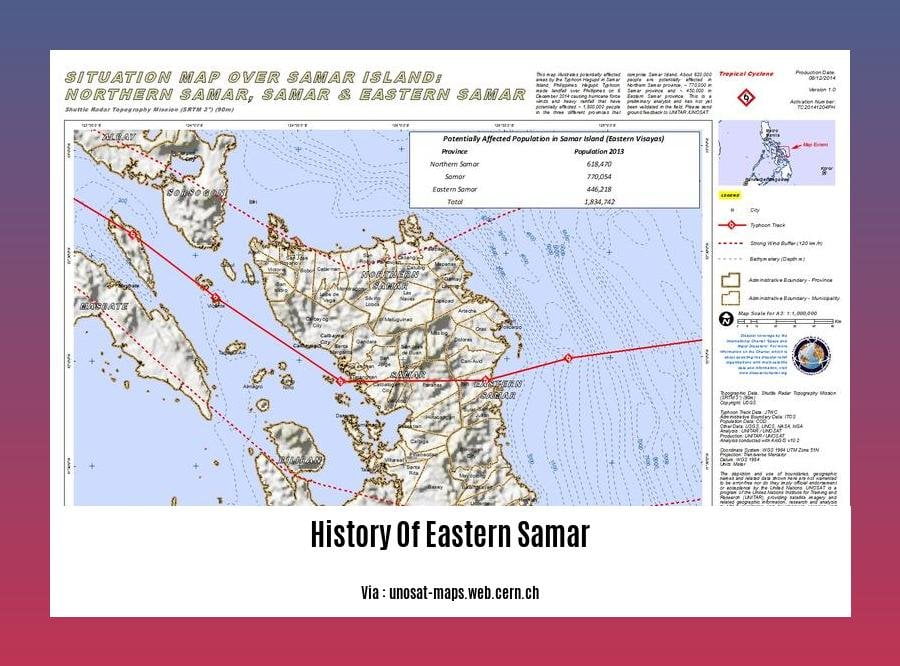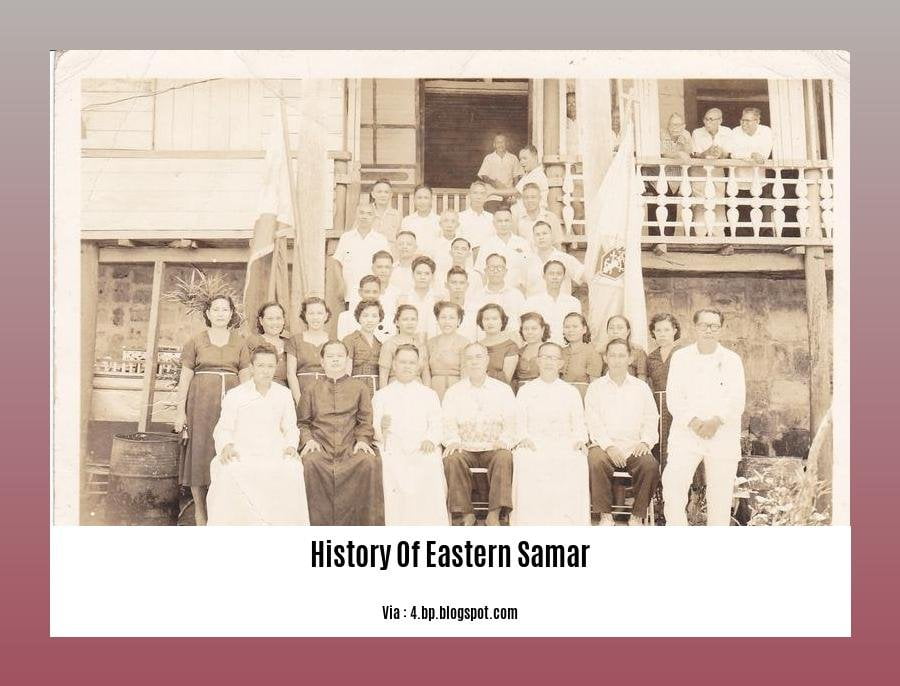Delve into the depths of time as we embark on a captivating journey to uncover the rich history of Eastern Samar in our article “Tracing the Footprints of Time: Unearthing the Rich History of Eastern Samar”. Join us as we unravel the mysteries of this enchanting region, where ancient civilizations left behind a tapestry of cultural heritage waiting to be discovered.
Key Takeaways:
Spanish explorer Ferdinand Magellan and his crew first sighted Eastern Samar, a province in the Philippines, on March 16, 1521.
Eastern Samar holds the distinction of being the first landmass in the Philippines to be spotted by Ferdinand Magellan and his crew.
On September 28, 1901, the people of Eastern Samar staged an ambush against American forces in Balangiga, an event known as the Balangiga attack.
Eastern Samar gained its independence as a province on June 19, 1965, when the former province of Samar was divided into three: Northern Samar, Western Samar, and Eastern Samar.
The division of Samar into three provinces was officially enacted by Republic Act No. 4221, approved by Congress on June 19, 1965.
History of Eastern Samar

Let’s travel back in time to unravel the captivating history of Eastern Samar. This enigmatic province in the Philippines has a rich tapestry of tales waiting to be explored.
A Voyage of Discovery
In 1521, history’s course changed when Ferdinand Magellan and his valiant crew stumbled upon Eastern Samar’s shores. They were the first Westerners to set foot on these lands, marking the beginning of a new chapter in the region’s story.
From Conquest to Resistance
The arrival of the Spanish colonizers brought about a period of conquest and assimilation. However, the Eastern Samar people fiercely resisted foreign rule, culminating in the heroic Balangiga attack of 1901. This audacious assault against American forces remains a testament to the region’s unwavering spirit of independence.
Birth of a Province
In 1965, Eastern Samar emerged as an independent province, breaking away from the larger Samar region. This marked a significant milestone in the province’s journey towards self-governance and autonomy.
Cultural Treasures
Eastern Samar boasts a wealth of cultural treasures, showcasing the province’s diverse heritage. From historical landmarks like the Balangiga Church to colorful festivals like the Pintados-Kasadyaan Festival, the region pulsates with vibrant traditions and cultural expressions.
In the Spotlight
In recent years, Eastern Samar has gained recognition for its historical significance. The province’s rich past has attracted the attention of historians, archaeologists, and tourists alike, eager to explore its hidden gems and unravel its captivating stories.
Conclusion
Eastern Samar’s history is a symphony of courage, resilience, and cultural diversity. It’s a narrative that continues to captivate and inspire, showcasing the indomitable spirit of a region that proudly embraces its past while forging a path towards a vibrant future.
Are you interested in delving into the captivating history of East Africa? Look no further! Our comprehensive O level notes provide an in-depth exploration of the region’s past. Click here to embark on a journey through time and discover the rich heritage of East Africa. history of east africa o level notes
Discover the fascinating history of the East Central and Western Africa (ECWA) church! From its humble beginnings to its current status as a major religious organization, our detailed account offers a glimpse into the ECWA’s profound impact on the spiritual landscape of East Africa. Click here to delve into the history of the ECWA and gain insights into the power of faith. history of ecwa
Embark on a captivating journey through the annals of El Nido, Palawan! Our comprehensive account unveils the intriguing history of this enchanting paradise, from its humble origins to its transformation into a world-renowned tourist destination. Click here to uncover the captivating story of El Nido, Palawan, and immerse yourself in its rich cultural heritage. history of el nido palawan
Arrival of Spanish Colonizers: The Reshaping of Eastern Samar
The arrival of Spanish colonizers in Eastern Samar marked a significant turning point in the region’s history. This transformative period left an indelible mark on the region, reshaping its cultural, social, and political landscapes forever.
The Arrival
Ferdinand Magellan and his crew were the first Europeans to set foot on Eastern Samar in 1521, opening up the region to Spanish influence. Their arrival marked the beginning of a period of conquest and assimilation, as the Spanish sought to expand their empire and Catholicize the native population.
Resistance and Resilience
The Eastern Samar people fiercely resisted Spanish rule, refusing to succumb to foreign domination. This resistance culminated in the heroic Balangiga attack of 1901, when Filipino insurgents successfully launched a surprise attack on American forces occupying the town of Balangiga. This audacious act of defiance became a symbol of Eastern Samar’s unwavering spirit and determination to fight for independence.
A Legacy of Change
The Spanish colonization of Eastern Samar brought about profound changes to the region. The introduction of Christianity, new crops, and Spanish language and customs had a lasting impact on the culture and way of life of the Eastern Samar people. The region’s economy shifted towards agriculture, as the Spanish encouraged the cultivation of cash crops such as rice, sugarcane, and abaca.
Key Takeaways:
The arrival of Spanish colonizers marked a transformative period in Eastern Samar’s history.
The Spanish sought to expand their empire and Catholicize the native population.
The Eastern Samar people fiercely resisted Spanish rule, culminating in the heroic Balangiga attack of 1901.
The Spanish colonization brought about significant cultural, social, and economic changes to Eastern Samar.
Citations:
- Brief History of Eastern Samar
- The Historical Islands of Eastern Samar
Struggle for Independence: Eastern Samar in the Philippine Revolution

Amidst the tapestry of Philippine history, the struggle for independence in Eastern Samar during the Philippine Revolution shines as a beacon of courage and resilience. This unsung chapter in the narrative of our nation’s fight for freedom is a testament to the unwavering spirit of the Eastern Samar people, who valiantly fought for their right to self-governance.
Join us as we delve into the chronicles of Eastern Samar’s heroic journey towards independence:
The Spark of Rebellion:
When the Philippine Revolution erupted in 1896, Eastern Samar echoed with the clarion call for independence, led by towering figures like General Vicente Lukban and Colonel Eugenio Daza.
These intrepid leaders rallied their fellow Eastern Samarans, igniting the flames of resistance against Spanish colonial rule.
A Saga of Battles and Bravery:
The Eastern Samar revolutionaries engaged in a relentless campaign of guerrilla warfare, striking strategic blows against Spanish forces.
The Battle of Balangiga, fought in 1901, stands out as a pivotal moment in Eastern Samar’s struggle for freedom.
The successful assault on the American garrison in Balangiga, led by the legendary Valeriano Abanador, exemplified the Eastern Samarans’ unwavering defiance.
The Road to Independence:
With the Philippine-American War raging, Eastern Samar remained a stronghold of resistance, refusing to succumb to American occupation.
The Eastern Samar revolutionaries, under the leadership of General Vicente Lukban, continued to wage a fierce guerrilla campaign against the Americans.
In 1901, Eastern Samar became the last province in the Philippines to surrender to American forces, underscoring their indomitable spirit and commitment to freedom.
Key Takeaways:
Eastern Samar was a hotbed of resistance against Spanish and American rule during the Philippine Revolution.
The Battle of Balangiga stands as a testament to the courage and determination of the Eastern Samar people.
Eastern Samar was the last province in the Philippines to surrender to American forces, demonstrating their unwavering commitment to independence.
Citation:
– History of Eastern Samar
– Eastern Samar: A Historical and Cultural Profile
Post-Independence Eastern Samar: A Legacy of Resilience and Growth
Chronicle the epic journey of Eastern Samar, a region that emerged from the ashes of colonialism, into a self-governing province, fueled by resilience, resourcefulness, and a deep-rooted commitment to progress.
Unveiling Eastern Samar’s Transformative Journey
Imagine a phoenix rising from the ashes, its vibrant wings outstretched, soaring towards a new dawn. This is the essence of Eastern Samar, a province that has emerged from the crucible of history, transformed by fierce determination and the unwavering belief in its own potential.
Eastern Samar’s narrative of independence, beginning in 1965, is a tapestry woven with courage, resilience, and a profound longing for self-governance. The province, with its rich cultural heritage deeply intertwined with its indomitable spirit, embarked on a path of development, fueled by the unwavering determination of its people.
The New Horizon: Eastern Samar Forges Its Destiny
As the curtain of colonial rule lifted, Eastern Samar stood at a crossroads, poised to chart its own destiny. With the passage of Republic Act No. 4221 in 1965, the province emerged as a distinct entity, free to pursue its own development trajectory.
This newfound independence ignited a spark of hope and ambition within the hearts of Eastern Samar’s people. They recognized the vast potential that lay within their province, untapped resources waiting to be harnessed, and a wealth of cultural traditions waiting to be celebrated.
Embracing Resilience: Overcoming Challenges, Fostering Growth
The road to progress, however, was not without obstacles. Eastern Samar, like many other provinces, faced its share of challenges: natural calamities, economic setbacks, and the need to bridge the gap between rural and urban development.
But amidst adversity, the spirit of resilience shone through. The province’s people, united in their determination, found strength in their shared heritage and cultural identity. They worked tirelessly, pooling their resources, and leveraging their collective talents to overcome obstacles and create opportunities.
Charting a Course for Progress: Agriculture, Industry, and Tourism
With a deep understanding of their unique strengths and potential, Eastern Samar’s leaders and stakeholders embarked on a strategic path of development. Agriculture, with its fertile lands and diverse crops, became a cornerstone of the province’s economy.
Local industries, harnessing the province’s natural resources and skilled workforce, flourished. Fishing, mining, and manufacturing sectors contributed significantly to Eastern Samar’s economic growth, creating jobs and fostering entrepreneurship.
Recognizing the allure of its pristine beaches, lush landscapes, and vibrant culture, Eastern Samar embraced tourism as a key driver of growth. The province’s historical landmarks, such as the Balangiga Church, and its colorful festivals, like the Pintados-Kasadyaan Festival, captivated visitors from near and far, showcasing the richness of Eastern Samar’s heritage.
Key Takeaways:
Eastern Samar’s journey to independence, marked by the enactment of Republic Act No. 4221 in 1965, symbolized the province’s determination to forge its own path.
Post-independence, Eastern Samar focused on economic development, harnessing its agricultural potential, fostering local industries, and promoting tourism.
The province’s resilience in the face of challenges, such as natural calamities and economic setbacks, contributed to its overall growth and progress.
Eastern Samar’s rich cultural heritage and vibrant festivals played a vital role in attracting tourism and showcasing the province’s unique identity.
The province’s commitment to sustainable development and community empowerment positioned it for continued growth and prosperity.
References:
Eastern Samar History, Geography, Economy – PeoPlaid Profile
FAQ
Q1: When did Eastern Samar become a separate province?
A1: Eastern Samar officially became an independent province on June 19, 1965, through the enactment of Republic Act No. 4221. This act divided the former province of Samar into three distinct provinces: Northern Samar, Western Samar (later renamed Samar), and Eastern Samar.
Q2: What significant event occurred in Eastern Samar involving the American forces?
A2: On September 28, 1901, the people of Eastern Samar launched an attack against American forces in Balangiga, known as the Balangiga attack. This event marked a pivotal moment in the Philippine-American War and demonstrated the resilience and resistance of the local population.
Q3: What historical islands are part of Eastern Samar?
A3: Eastern Samar encompasses several historical islands that hold cultural and historical significance. Three notable islands include Capul, Homonhon, and Suluan. These islands have played a role in shaping the region’s rich heritage and identity.
Q4: What was the significance of the arrival of Ferdinand Magellan in Eastern Samar?
A4: The arrival of Ferdinand Magellan and his crew in Eastern Samar in 1521 marked a pivotal moment in the region’s history. It initiated contact between the indigenous population and European explorers, leading to significant changes and interactions that influenced the cultural and historical trajectory of Eastern Samar.
Q5: What are some of the earliest Jesuit settlements in Eastern Samar?
A5: Among the earliest Jesuit settlements established in Eastern Samar were Bacod (Dolores), Jubasan, and Tubig (Taft). These settlements played a crucial role in spreading Catholicism and played a significant role in shaping the religious and cultural landscape of the region.















